
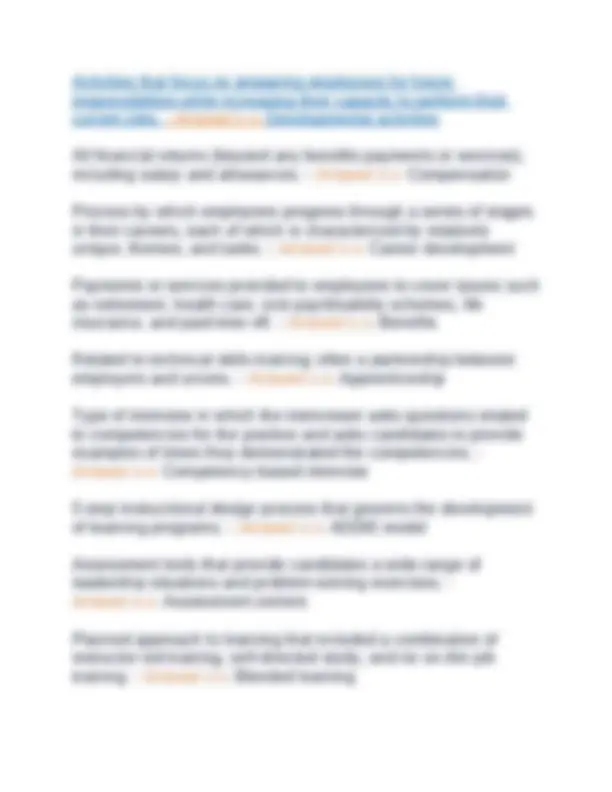
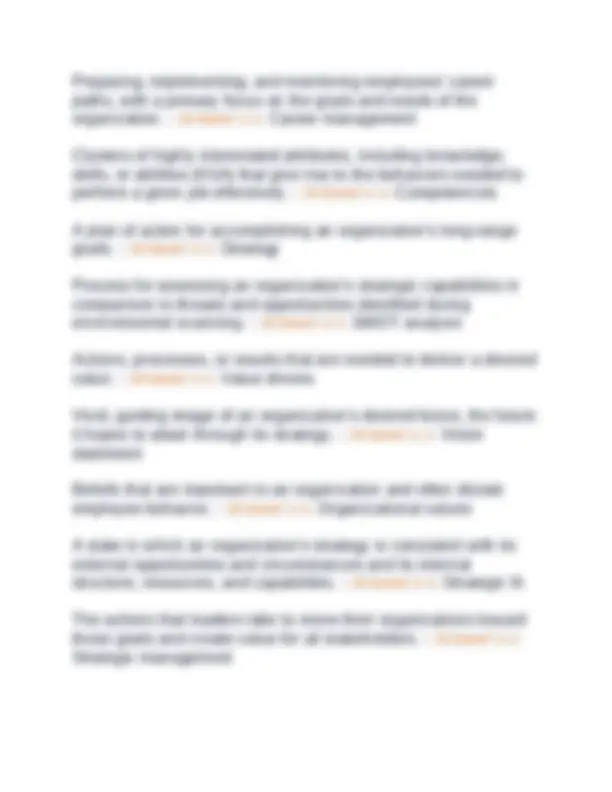
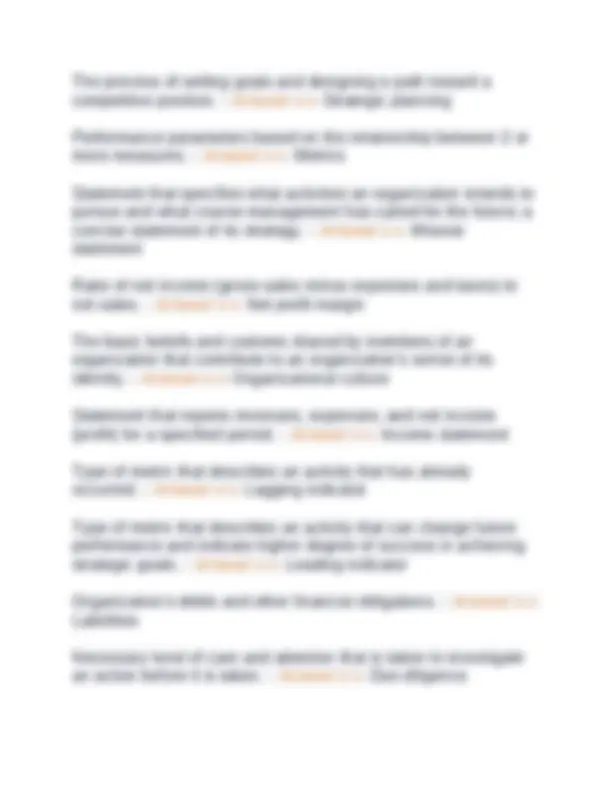
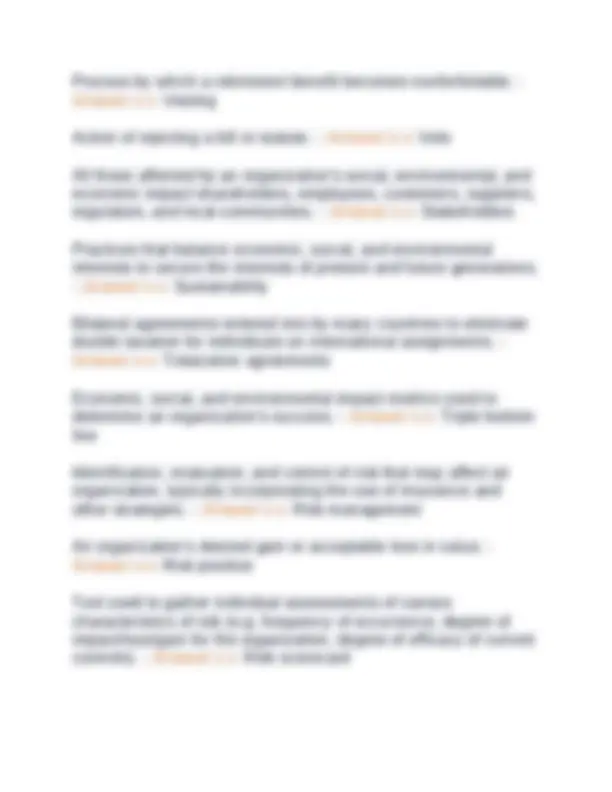
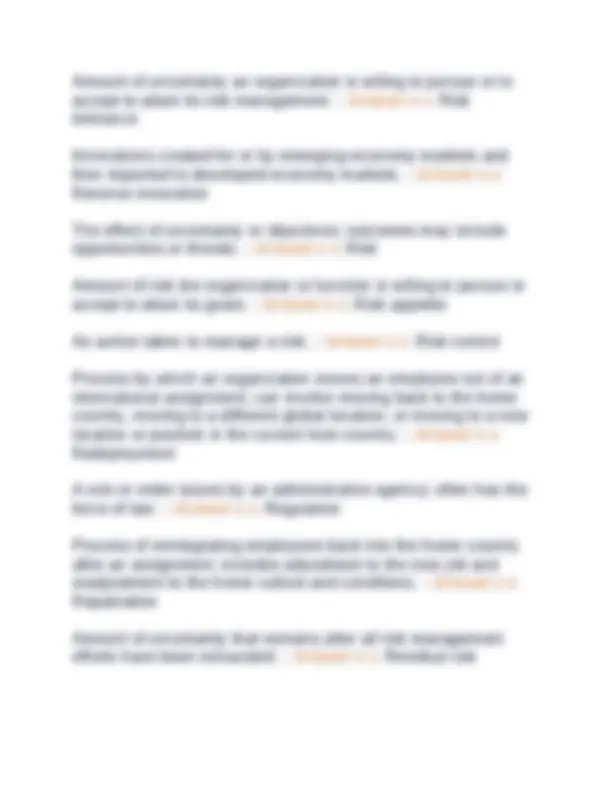
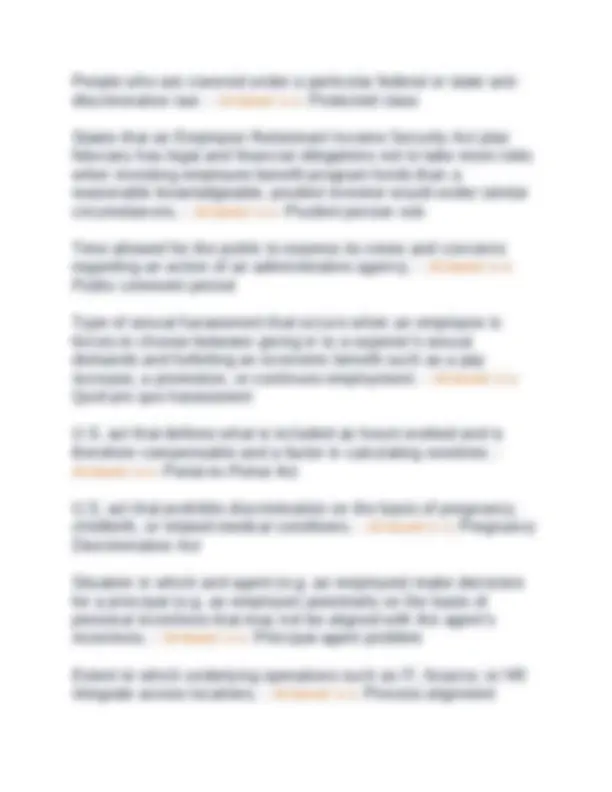
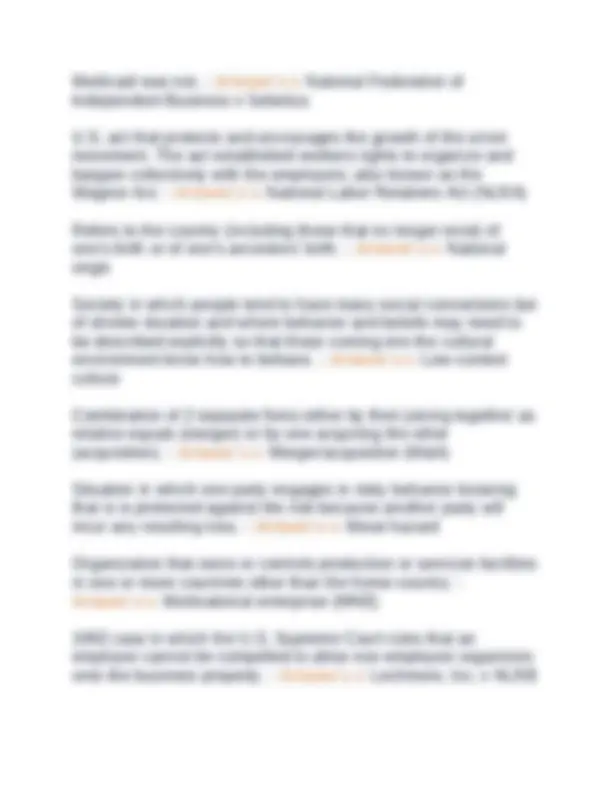
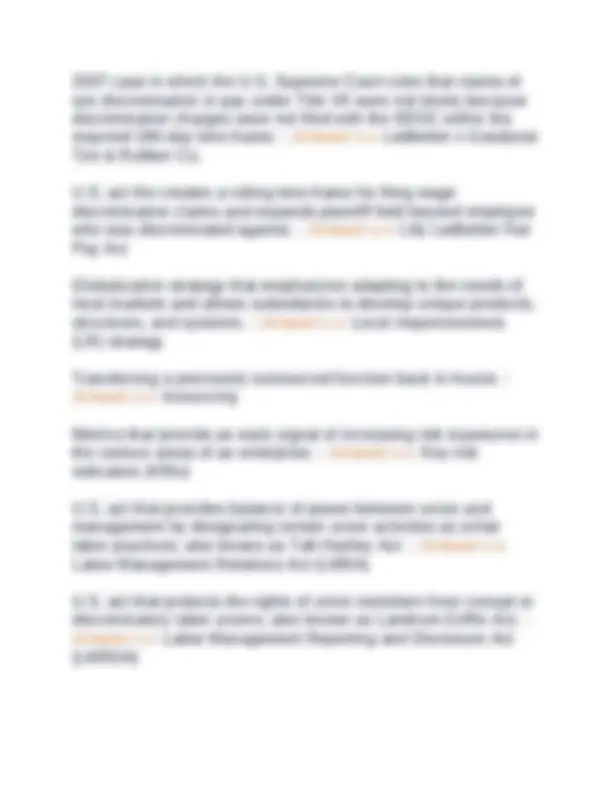
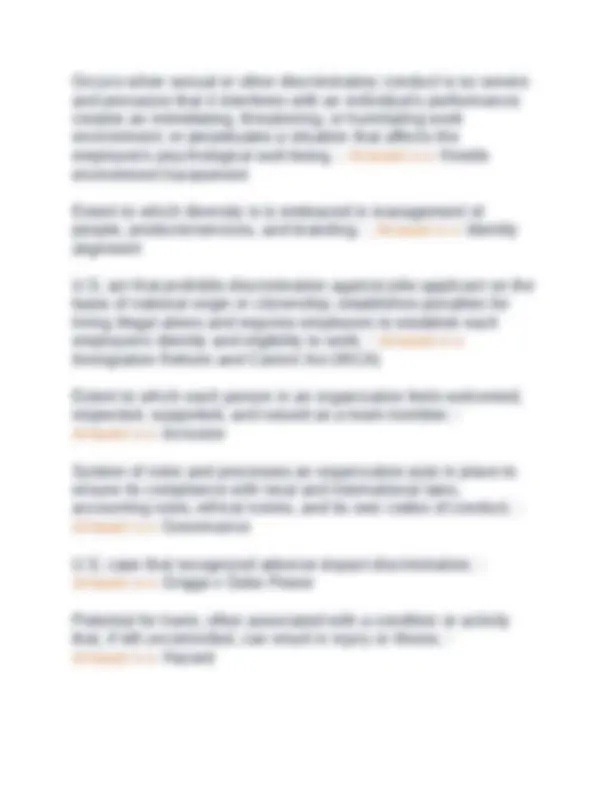
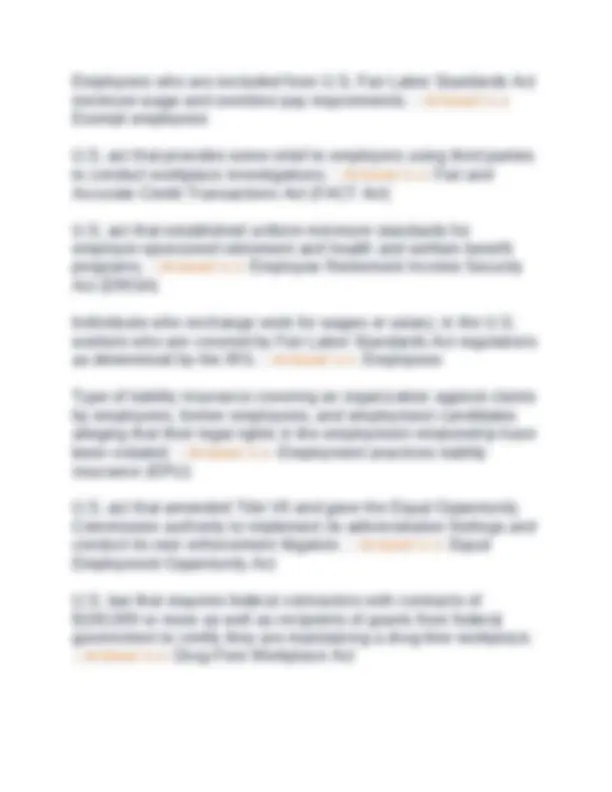
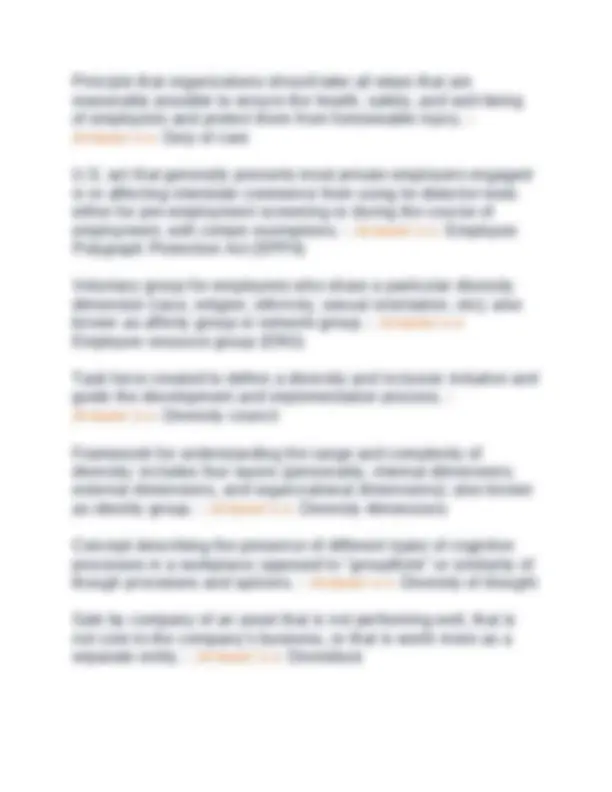
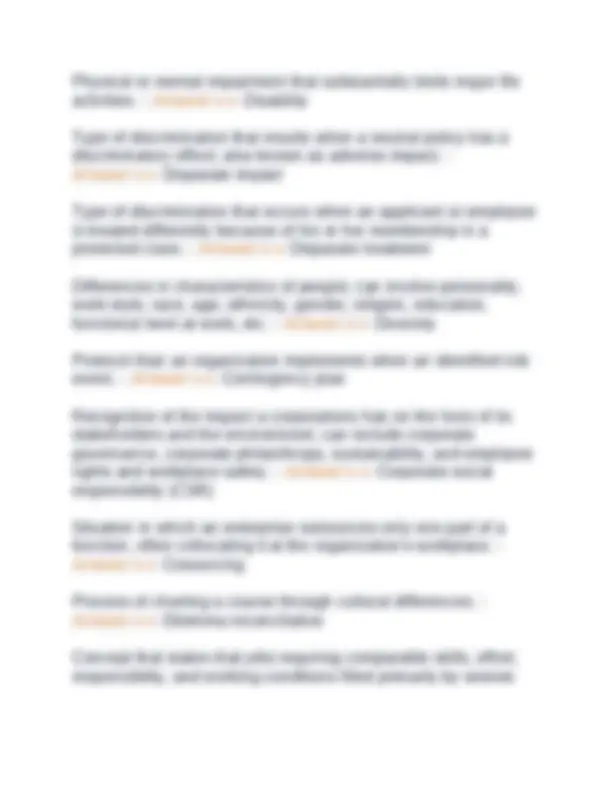
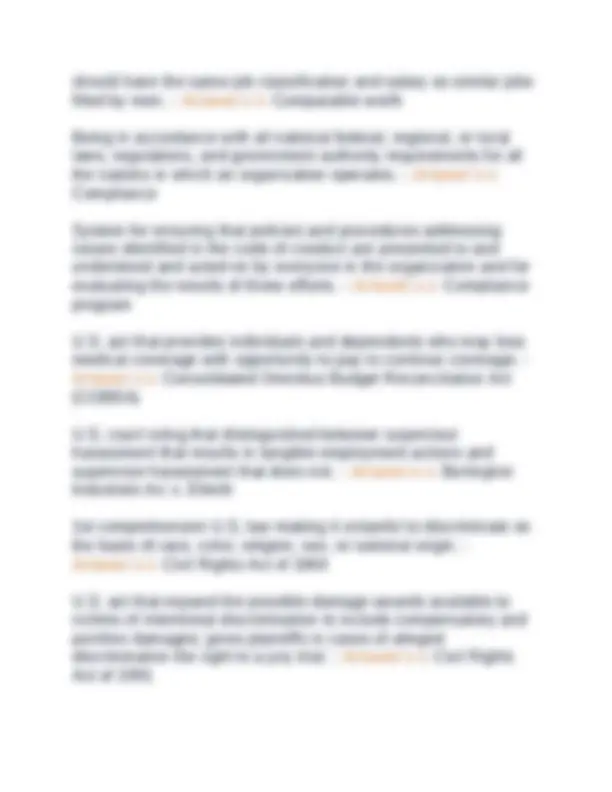

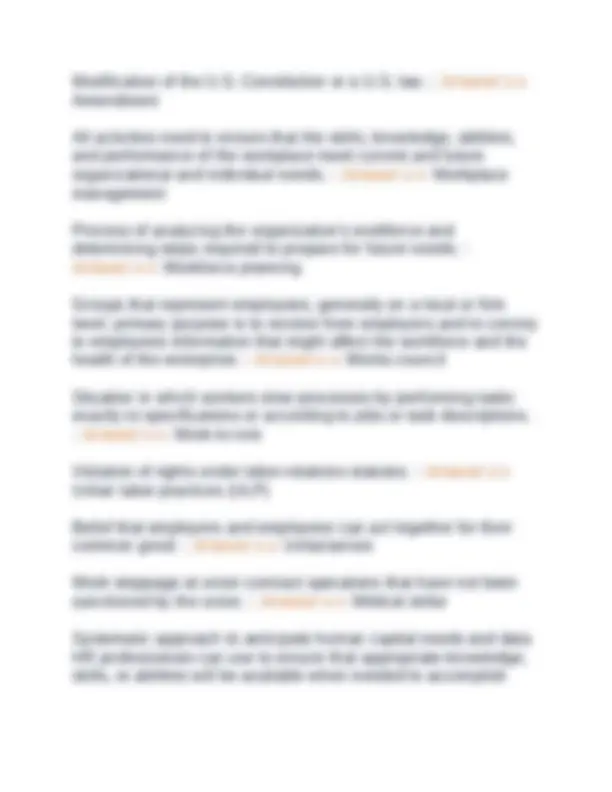
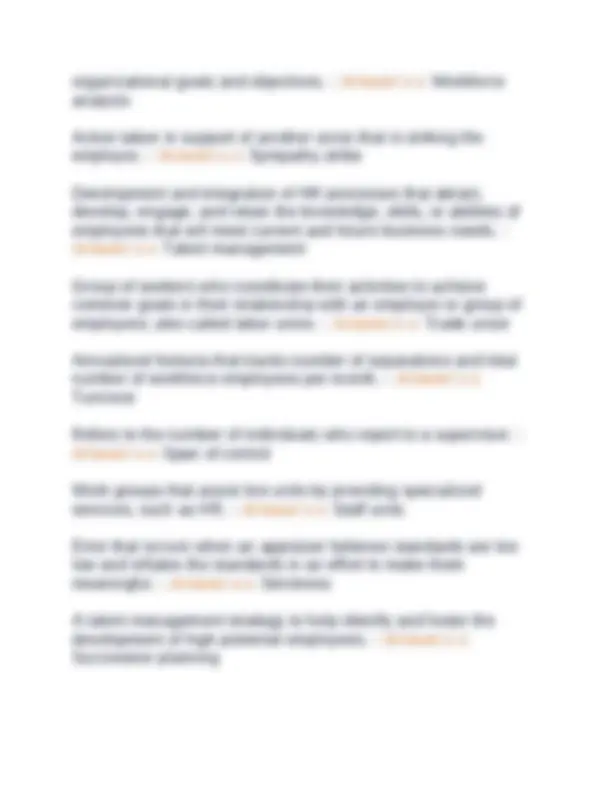

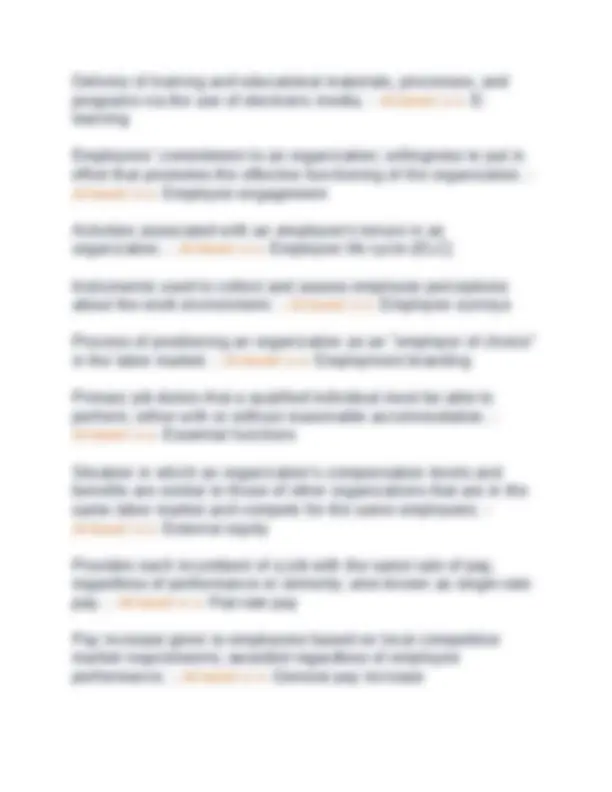
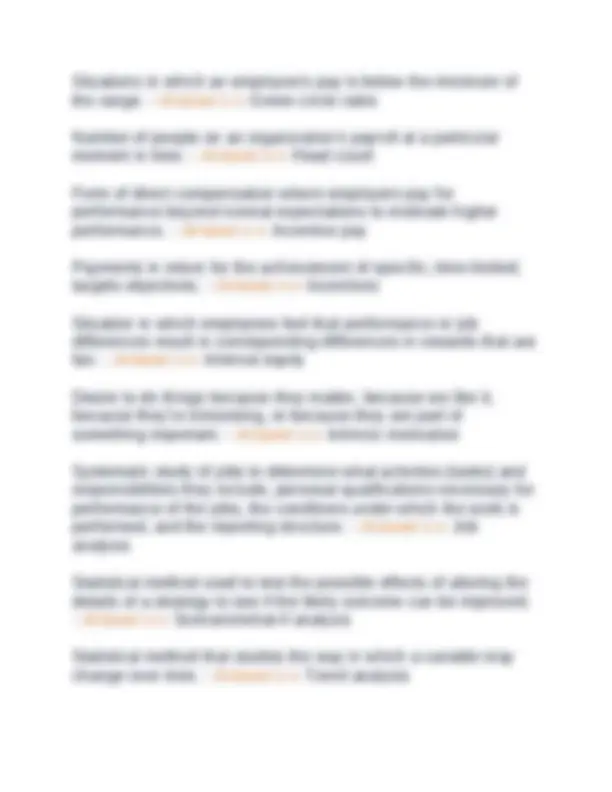
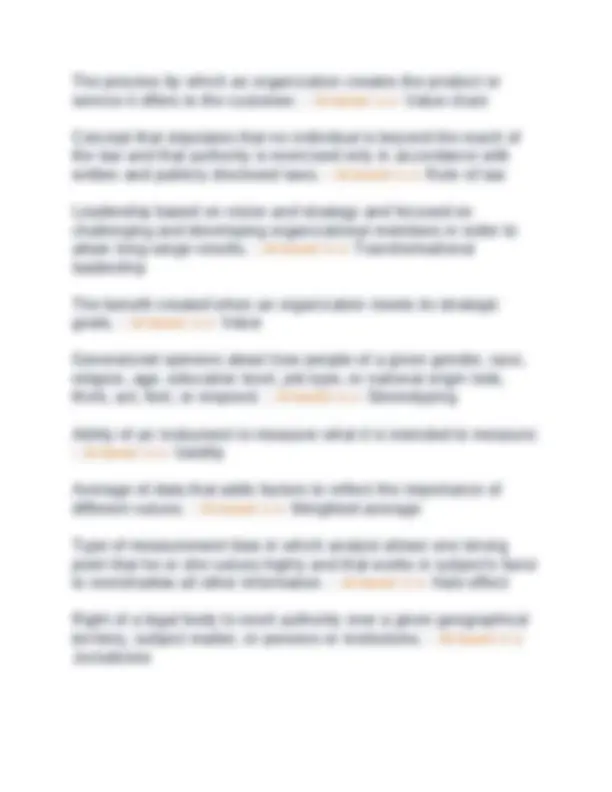
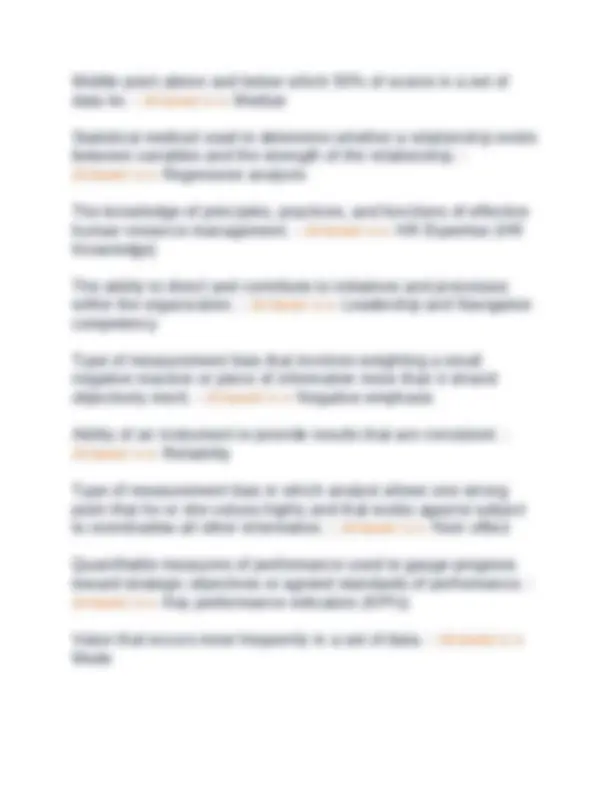
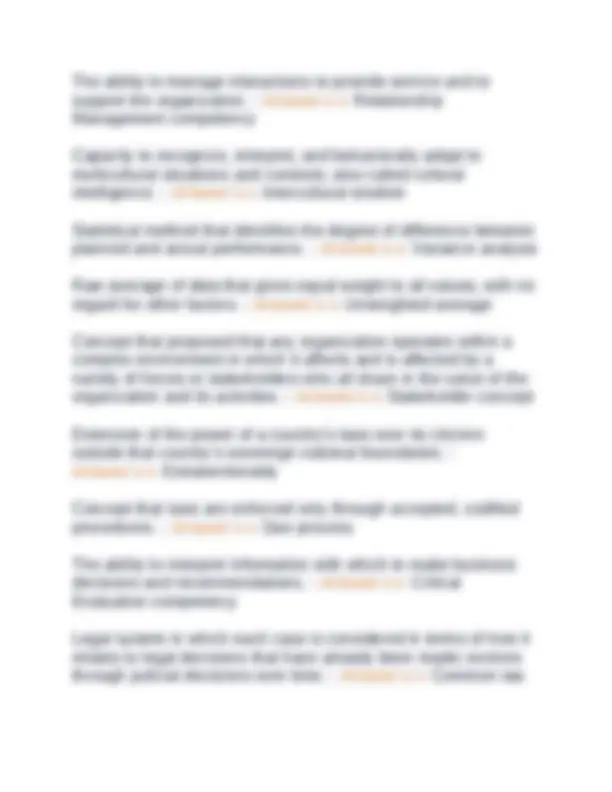
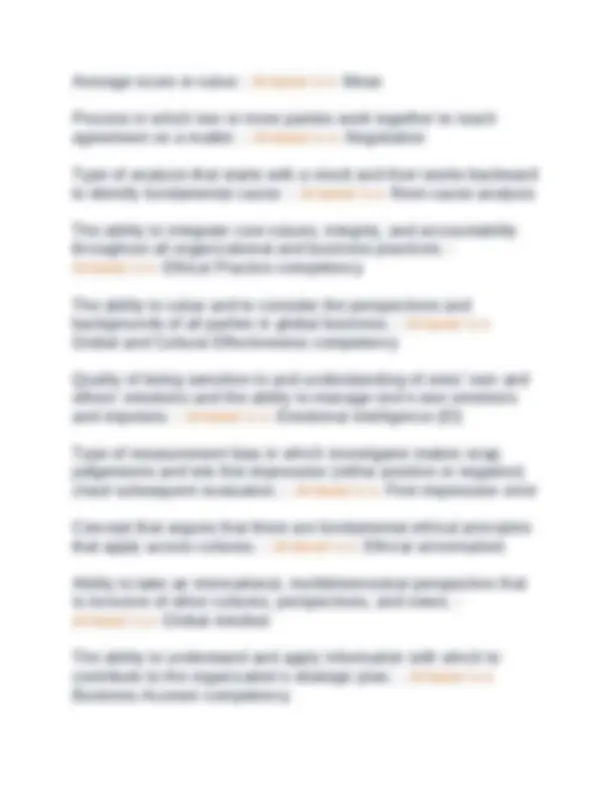
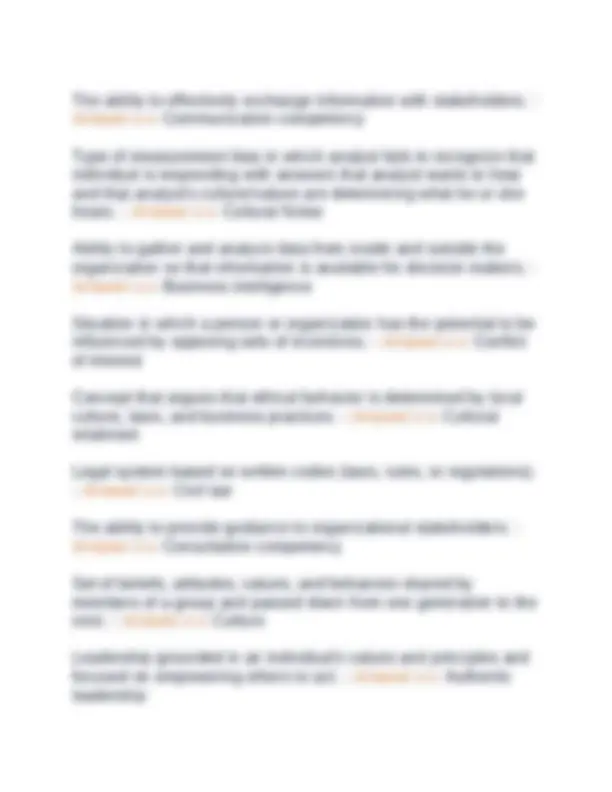
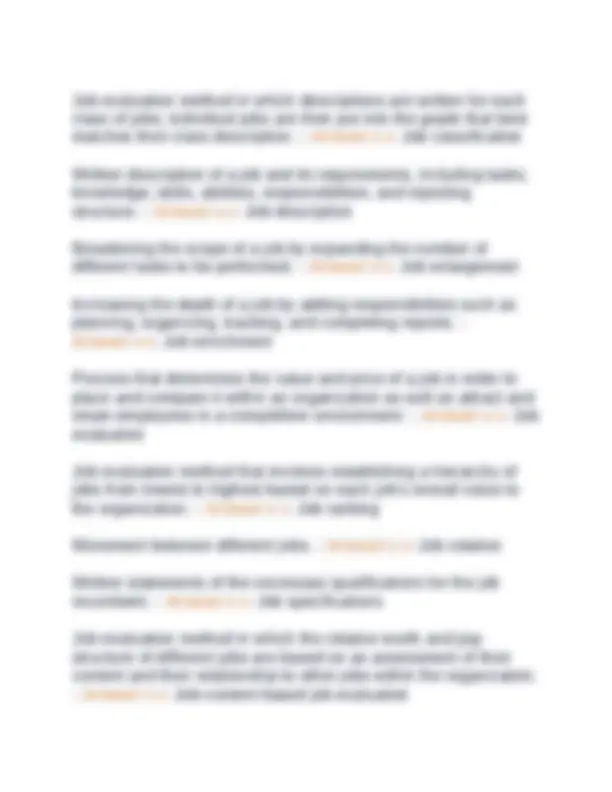
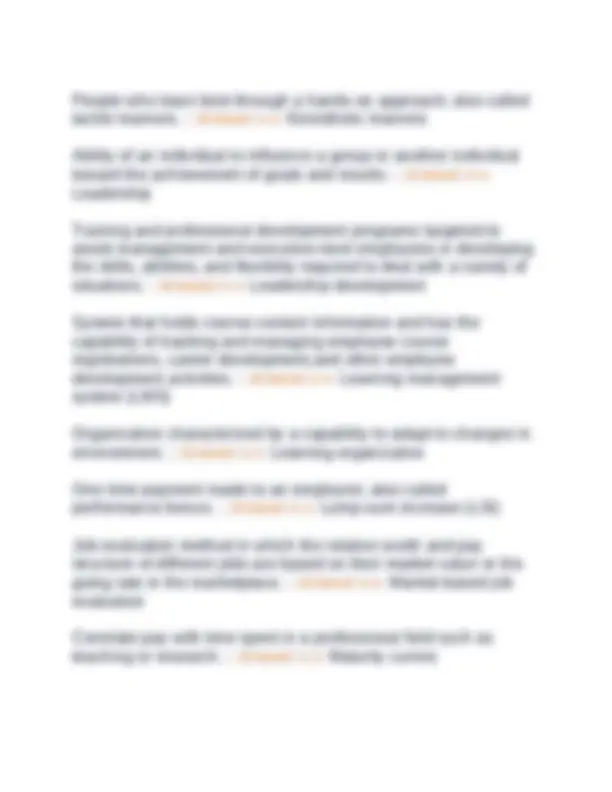
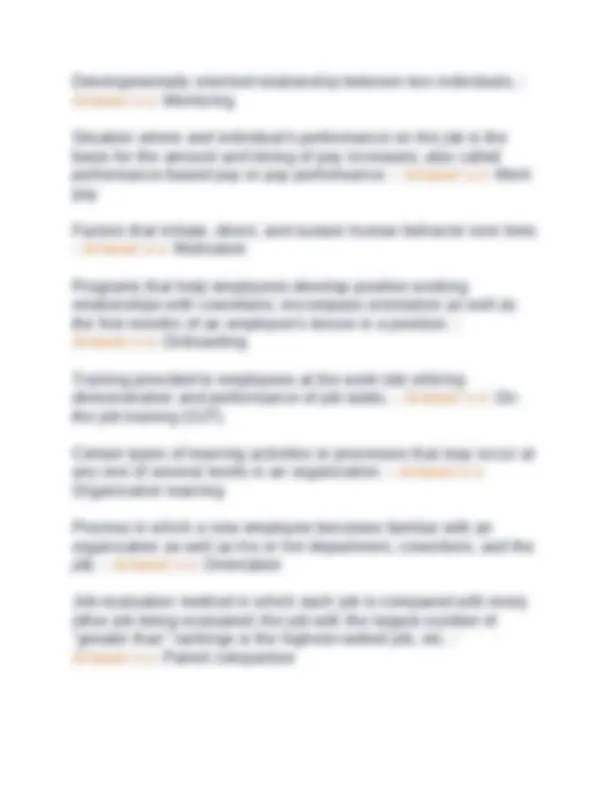
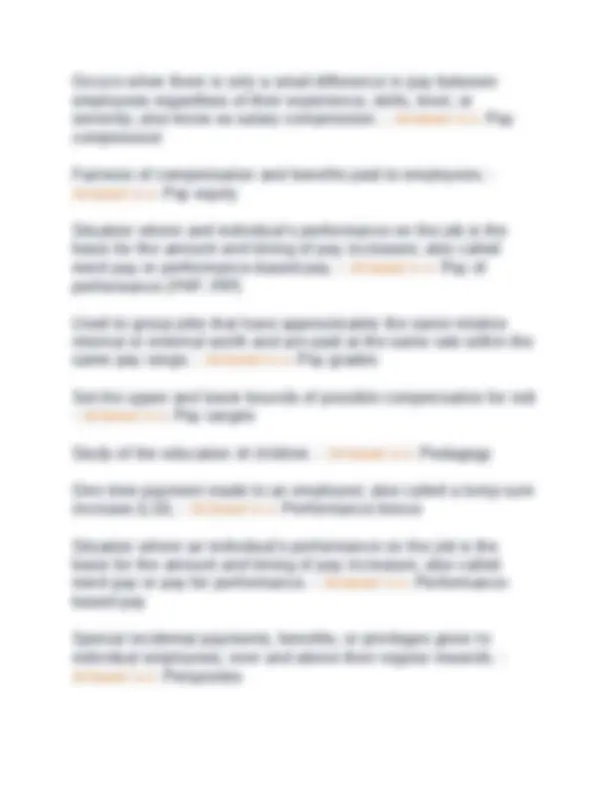
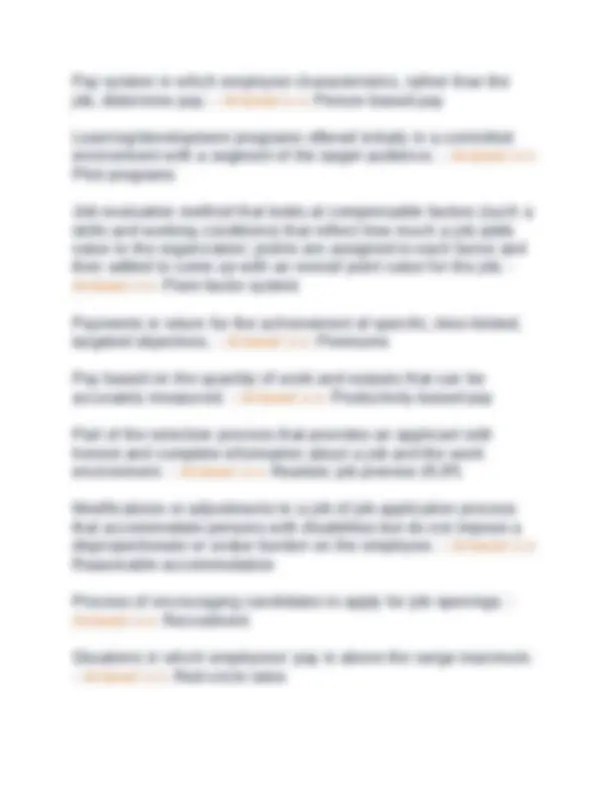
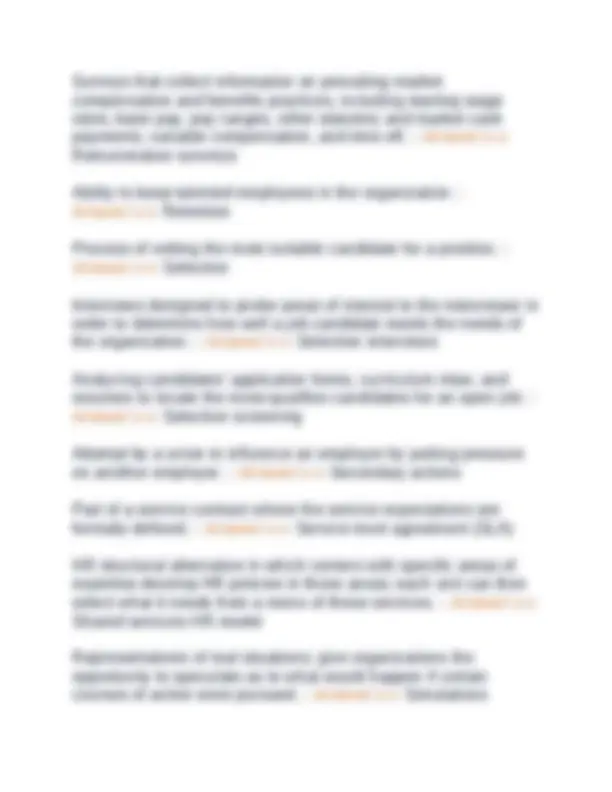
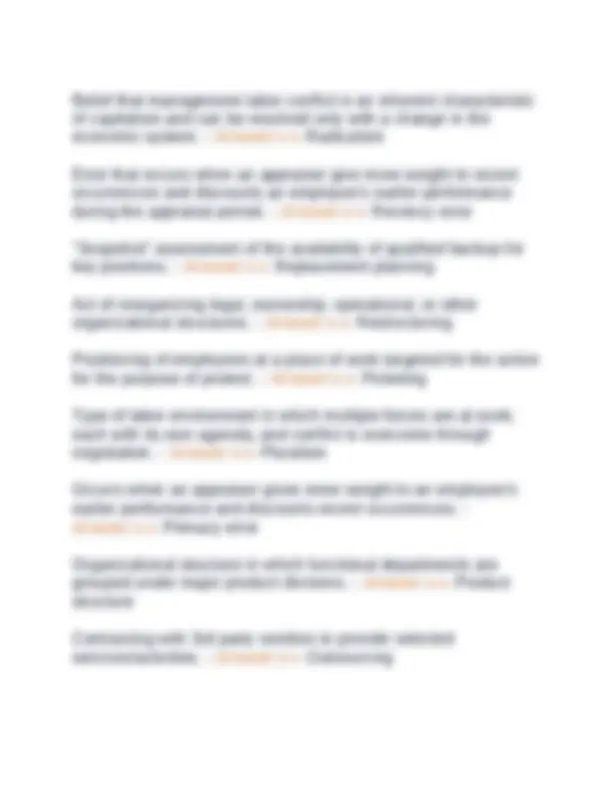
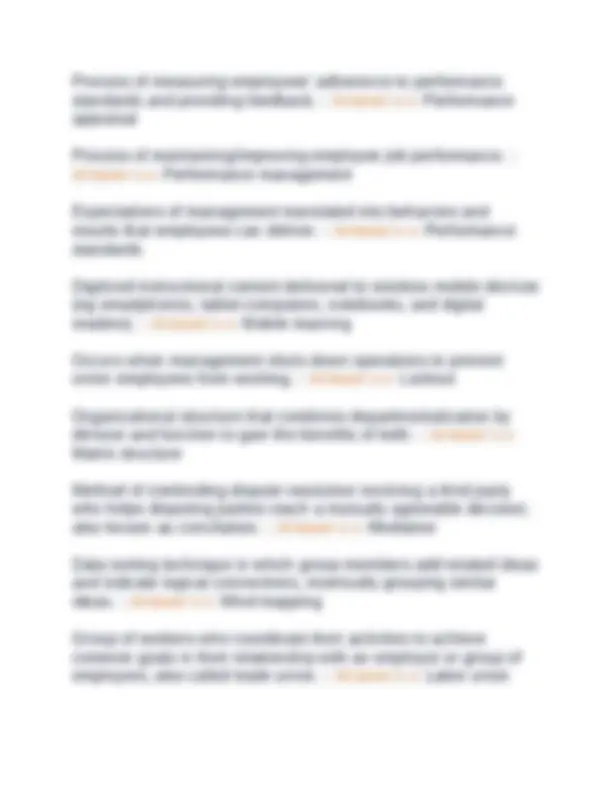
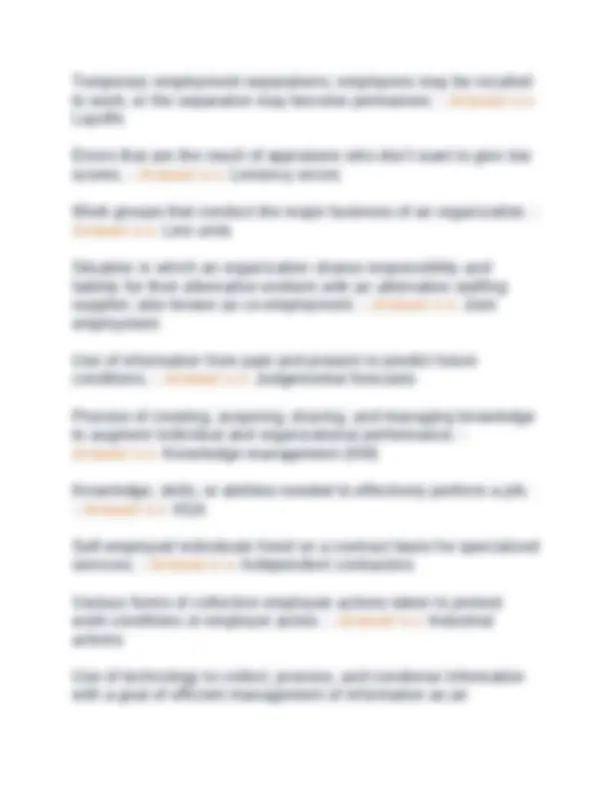
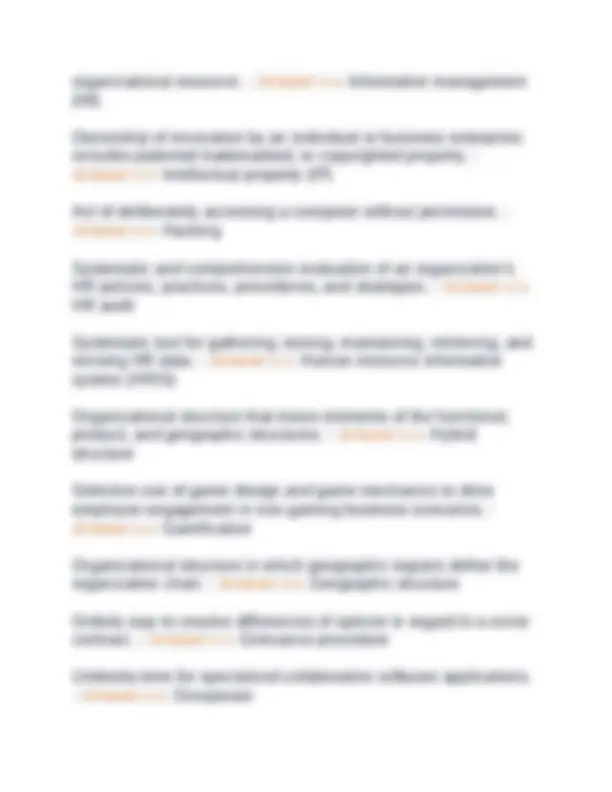
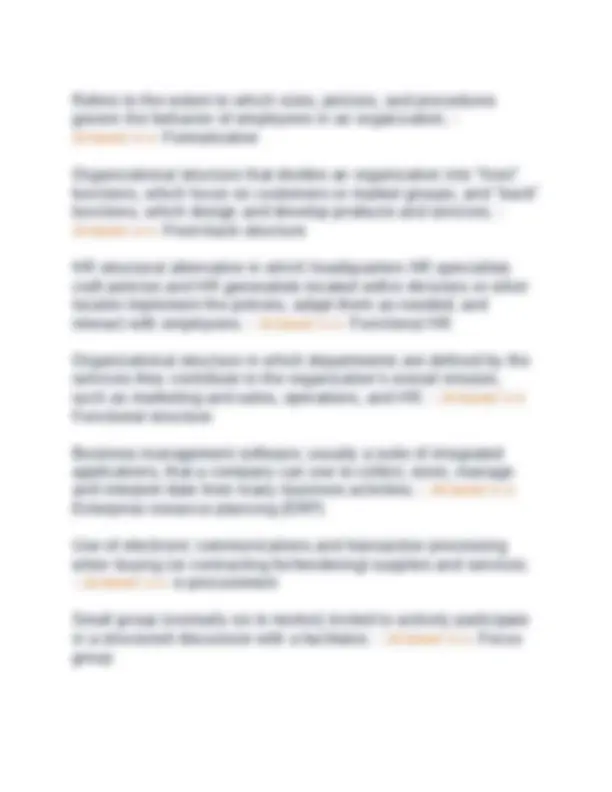
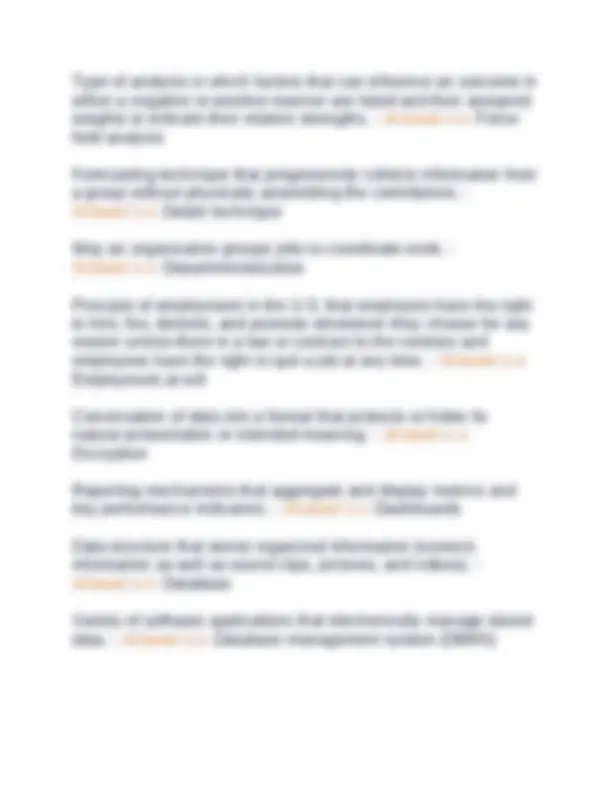
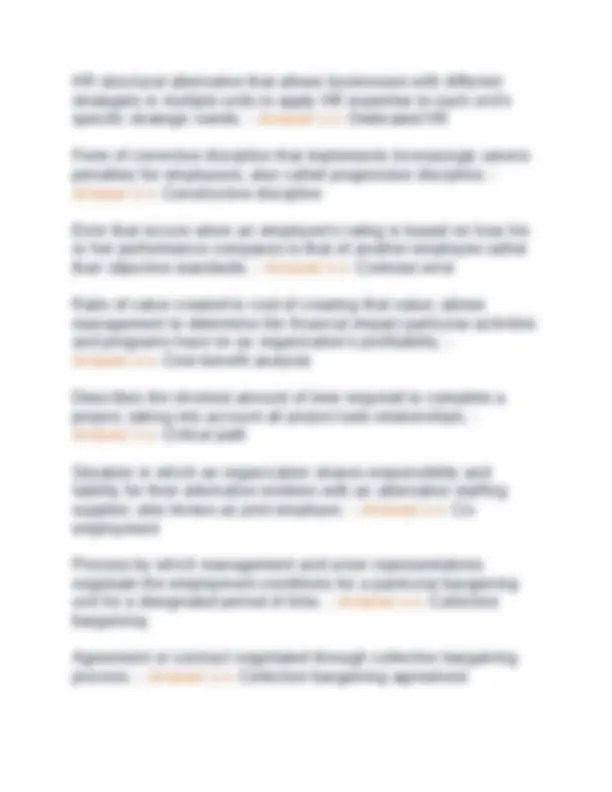
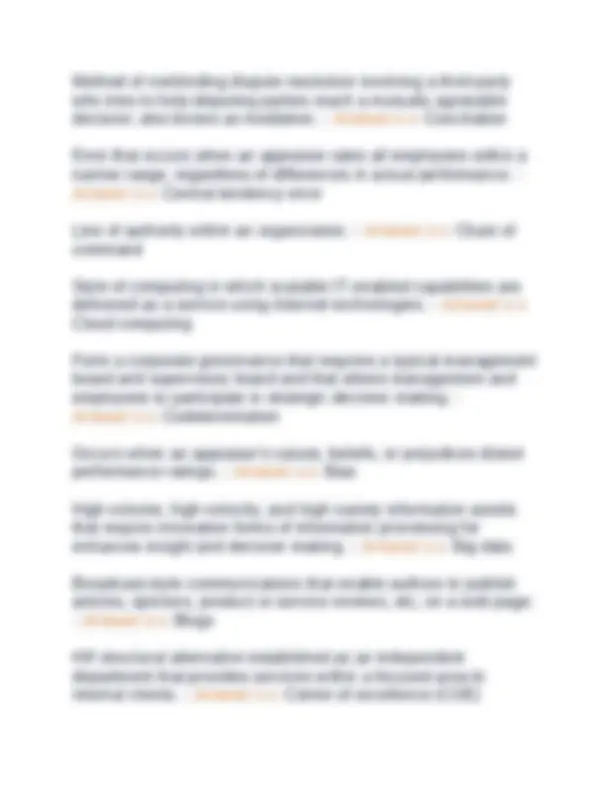
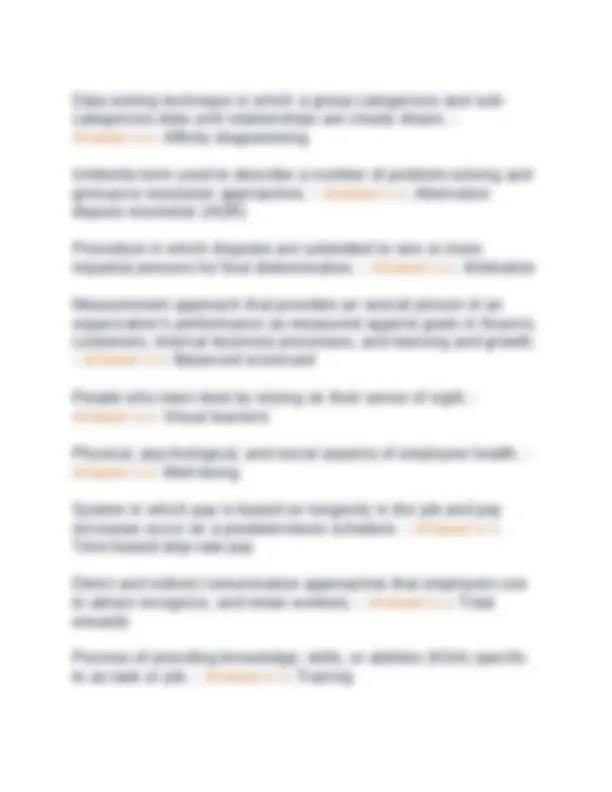
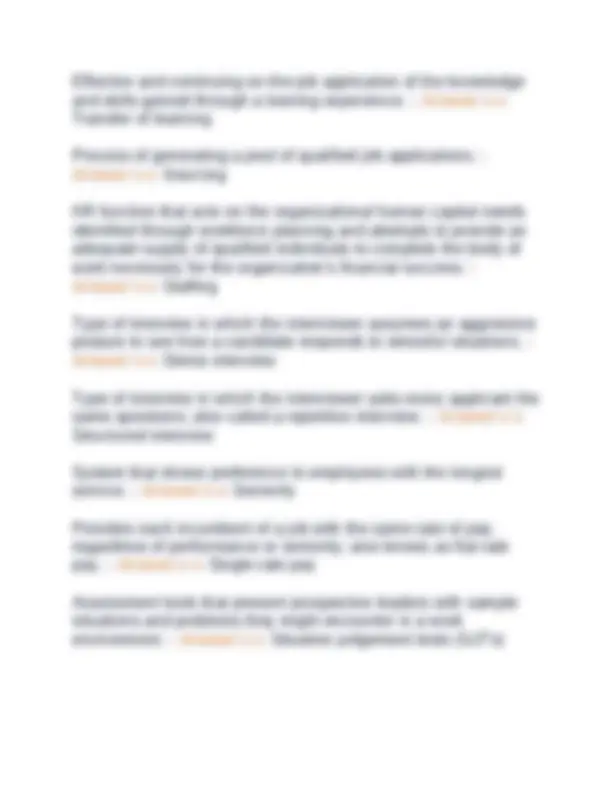
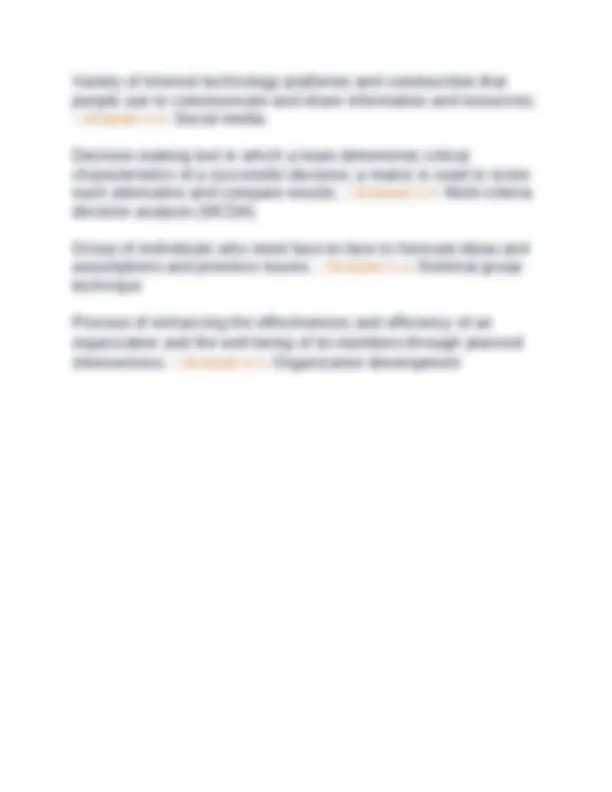


Study with the several resources on Docsity

Earn points by helping other students or get them with a premium plan


Prepare for your exams
Study with the several resources on Docsity

Earn points to download
Earn points by helping other students or get them with a premium plan
Community
Ask the community for help and clear up your study doubts
Discover the best universities in your country according to Docsity users
Free resources
Download our free guides on studying techniques, anxiety management strategies, and thesis advice from Docsity tutors
A wide range of human resource management (hrm) concepts and terminology, including topics related to compensation, benefits, employee relations, labor laws, and workplace policies. It provides definitions and explanations for various hr-related terms and concepts, such as andragogy, applicant tracking software, career development, overtime pay, the patient protection and affordable care act, the fair labor standards act, exempt and non-exempt employees, employee discrimination, workplace safety, and more. A comprehensive reference or glossary of hrm terminology, which could be useful for students, hr professionals, or anyone interested in understanding the key concepts and regulations governing the employment relationship.
Typology: Exams
1 / 49

This page cannot be seen from the preview
Don't miss anything!










































David Mungai [Date] [Course title]
Actions & activities that individuals perform in order to give direction to their work lives. - Answer>> Career Planning Exit of educated & skilled citizens from emerging & developing countries for better paying jobs in developed countries. - Answer>> Brain drain People who learn best by relying on their sense of hearing. - Answer>> Auditory learners Study of how adults learn. - Answer>> Andragogy Pay adjustment given to eligible employees regardless of performance or organizational profitability; usually linked to inflation. - Answer>> Cost-of-living adjustment (COLA) Pay rate divided by the midpoint of the pay range. - Answer>> Compa-ratio Combining several salary grades or job classifications with narrow pay ranges unto one brand with a wider salary spread. - Answer>> Broadbanding Type of interview that focuses on how applicants previously handled real situations. - Answer>> Behavioral interview Software that provides an automated way for organizations to manage the recruiting process. - Answer>> Applicant tracking software (ATS)
Preparing, implementing, and monitoring employees' career paths, with a primary focus on the goals and needs of the organization. - Answer>> Career management Clusters of highly interrelated attributes, including knowledge, skills, or abilities (KSA) that give rise to the behaviors needed to perform a given job effectively. - Answer>> Competencies A plan of action for accomplishing an organization's long-range goals. - Answer>> Strategy Process for assessing an organization's strategic capabilities in comparison to threats and opportunities identified during environmental scanning. - Answer>> SWOT analysis Actions, processes, or results that are needed to deliver a desired value. - Answer>> Value drivers Vivid, guiding image of an organization's desired future, the future it hopes to attain through its strategy. - Answer>> Vision statement Beliefs that are important to an organization and often dictate employee behavior. - Answer>> Organizational values A state in which an organization's strategy is consistent with its external opportunities and circumstances and its internal structure, resources, and capabilities. - Answer>> Strategic fit The actions that leaders take to move their organizations toward those goals and create value for all stakeholders. - Answer>> Strategic management
The process of setting goals and designing a path toward a competitive position. - Answer>> Strategic planning Performance parameters based on the relationship between 2 or more measures. - Answer>> Metrics Statement that specifies what activities an organization intends to pursue and what course management has carted for the future; a concise statement of its strategy. - Answer>> Mission statement Ratio of net income (gross sales minus expenses and taxes) to net sales. - Answer>> Net profit margin The basic beliefs and customs shared by members of an organization that contribute to an organization's sense of its identity. - Answer>> Organizational culture Statement that reports revenues, expenses, and net income (profit) for a specified period. - Answer>> Income statement Type of metric that describes an activity that has already occurred. - Answer>> Lagging indicator Type of metric that describes an activity that can change future performance and indicate higher degree of success in achieving strategic goals. - Answer>> Leading indicator Organization's debts and other financial obligations. - Answer>> Liabilities Necessary level of care and attention that is taken to investigate an action before it is taken. - Answer>> Due diligence
Money an organization's customers owe the organization. - Answer>> Accounts receivable Financial, physical, and sometimes intangible properties an organization owns. - Answer>> Assets Statement that reports the financial position of the organization at a specific point in time; shows assets, liabilities, and shareholder equity. - Answer>> Balance sheet Legal doctrine under which a party can be held liable for the wrongful actions of another party. - Answer>> Vicarious liability Union employees' right in U.S. to have a union representative or coworker present during an investigatory interview. - Answer>> Weingarten rights U.S. act that requires some employers to give a minimum of 60 days' notice if a plant is to close or is mass layoffs will occur. - Answer>> Worker Adjustment and Retraining Notification (WARN) Act Any fixed, recurring period of 168 consecutive hours (7 days time 24 hours = 168 hrs) - Answer>> Workweek Procedural document designed to assist employers in complying with federal regulations prohibiting discrimination. - Answer>> Uniform Guidelines on Employee Selection Procedures U.S. act that protects the employment reemployment, and retention rights of persons who serve or have served in the uniformed services. - Answer>> Uniformed Services Employment and Reemployment Rights Act (USERRA)
Process by which a retirement benefit becomes nonforfeitable. - Answer>> Vesting Action of rejecting a bill or statute. - Answer>> Veto All those affected by an organization's social, environmental, and economic impact shareholders, employees, customers, suppliers, regulators, and local communities. - Answer>> Stakeholders Practices that balance economic, social, and environmental interests to secure the interests of present and future generations.
People who are covered under a particular federal or state anti- discrimination law. - Answer>> Protected class States that an Employee Retirement Income Security Act plan fiduciary has legal and financial obligations not to take more risks when investing employee benefit program funds than a reasonable knowledgeable, prudent investor would under similar circumstances. - Answer>> Prudent person rule Time allowed for the public to express its views and concerns regarding an action of an administrative agency. - Answer>> Public comment period Type of sexual harassment that occurs when an employee is forces to choose between giving in to a superior's sexual demands and forfeiting an economic benefit such as a pay increase, a promotion, or continues employment. - Answer>> Quid pro quo harassment U.S. act that defines what is included as hours worked and is therefore compensable and a factor in calculating overtime. - Answer>> Portal-to-Portal Act U.S. act that prohibits discrimination on the basis of pregnancy, childbirth, or related medical conditions. - Answer>> Pregnancy Discrimination Act Situation in which and agent (e.g. an employee) make decisions for a principal (e.g. an employer) potentially on the basis of personal incentives that may not be aligned with the agent's incentives. - Answer>> Principal-agent problem Extent to which underlying operations such as IT, finance, or HR integrate across locations. - Answer>> Process alignment
Required for nonexempt workers under U.S. Fair Labor Standards Act at 1.5 time the regular rate of pay for hours worked over 40 in a workweek. - Answer>> Overtime pay 2010 U.S. law the requires virtually all citizens and legal residents to have minimum health coverage and requires employers with more than 50 full-time employees to provide health coverage that meets minimum benefit specifications or pay a penalty. - Answer>> Patient Protections and Affordable Care Act (PPACA) Set up by U.S. Employee Retirement Income Security Act to insure payment of benefits in the even that a private-sector defined benefit pension plan terminates with insufficient funds to pay the benefits. - Answer>> Pension Benefit Guaranty Corporation (PBGC) 1971 U.S. case that stated than an employer may not, in the absence of business necessity, refuse to hire women with preschool aged children while hiring men with such children. - Answer>> Phillips v. Martin Marietta Corporation U.S. act that established the first national policy for safety and health and continues to deliver standards that employers must meet to guarantee the health and safety of their employees. - Answer>> Occupational Safety and Health Act (OSH) U.S. agency that administers and enforces the Occupational Safety and Health Act of 1970. - Answer>> Occupational Safety and Health Administration (OSHA)
Medicaid was not. - Answer>> National Federation of Independent Business v Sebelius U.S. act that protects and encourages the growth of the union movement. The act established workers rights to organize and bargain collectively with the employers; also known as the Wagner Act. - Answer>> National Labor Relations Act (NLRA) Refers to the country (including those that no longer exist) of one's birth or of one's ancestors' birth. - Answer>> National origin Society in which people tend to have many social connections but of shorter duration and where behavior and beliefs may need to be described explicitly so that those coming into the cultural environment know how to behave. - Answer>> Low-context culture Combination of 2 separate firms either by their joining together as relative equals (merger) or by one acquiring the other (acquisition). - Answer>> Merger/acquisition (M&A) Situation in which one party engages in risky behavior knowing that is is protected against the risk because another party will incur any resulting loss. - Answer>> Moral hazard Organization that owns or controls production or services facilities in one or more countries other than the home country. - Answer>> Multinational enterprise (MNE) 1992 case in which the U.S. Supreme Court rules that an employer cannot be compelled to allow non-employee organizers onto the business property. - Answer>> Lechmere, Inc. v NLRB
2007 case in which the U.S. Supreme Court rules that claims of sex discrimination in pay under Title VII were not timely because discrimination charges were not filed with the EEOC within the required 180-day time frame. - Answer>> Ledbetter v Goodyear Tire & Rubber Co, U.S. act the creates a rolling time frame for filing wage discrimination claims and expands plaintiff field beyond employee who was discriminated against. - Answer>> Lilly Ledbetter Fair Pay Act Globalization strategy that emphasizes adapting to the needs of local markets and allows subsidiaries to develop unique products, structures, and systems. - Answer>> Local responsiveness (LR) strategy Transferring a previously outsourced function back in-house. - Answer>> Insourcing Metrics that provide an early signal of increasing risk exposures in the various areas of an enterprise. - Answer>> Key risk indicators (KRIs) U.S. act that provides balance of power between union and management by designating certain union activities as unfair labor practices; also knows as Taft-Hartley Act. - Answer>> Labor-Management Relations Act (LMRA) U.S. act that protects the rights of union members from corrupt or discriminatory labor unions; also known as Landrum-Griffin Act. - Answer>> Labor-Management Reporting and Disclosure Act (LMRDA)
Society or group where people have close connections over a long period of time and where many aspects of behavior are not made explicit, because most members know what to do and thing from years of interaction. - Answer>> High-context culture Globalization strategy that emphasizes consistency of approach, standardization of processes, and a common corporate culture across global operations. - Answer>> Global integration (GI) strategy Monies sent back home by migrants working in foreign countries.
insurance. - Answer>> Genetic Information Nondiscrimination Act (GINA) U.S. act that protects privacy of background information and ensures that information supplies is accuate. - Answer>> Fair Credit Reporting Act (FCRA) U.S. act that establishes minimum wage, overtime pay, youth employment, and record-keeping standards affecting full-time and part-time workers in the private sector and in federal, state, and local governments. - Answer>> Fair Labor Standards Act (FLSA) U.S. act that provides employees with up to 12 weeks of unpaid leave to care for family members or because of a serious health condition of the employee. - Answer>> Family and Medical Leave Act (FMLA) U.S. court ruling that distinguished between supervisor harassment that results in tangible employment action and supervisor harassment that does not. - Answer>> Faragher v. City of Boca Raton U.S. act that prohibits wage discrimination by requiring equal pay for equal or "substantially equal" work. - Answer>> Equal Pay Act (EPA) Set of behavioral guidelines by which all directors, managers, and employees of an organization are expected to behave to ensure appropriate moral and ethical business standards, typically beyond the letter of the law. - Answer>> Ethics
Principle that organizations should take all steps that are reasonably possible to ensure the health, safety, and well-being of employees and protect them from foreseeable injury. - Answer>> Duty of care U.S. act that generally prevents most private employers engaged in or affecting interstate commerce from using lie detector tests either for pre-employment screening or during the course of employment, with certain exemptions. - Answer>> Employee Polygraph Protection Act (EPPA) Voluntary group for employees who share a particular diversity dimension (race, religion, ethnicity, sexual orientation, etc); also known as affinity group or network group. - Answer>> Employee resource group (ERG) Task force created to define a diversity and inclusion initiative and guide the development and implementation process. - Answer>> Diversity council Framework for understanding the range and complexity of diversity; includes four layers (personality, internal dimensions, external dimensions, and organizational dimensions); also known as identity group. - Answer>> Diversity dimensions Concept describing the presence of different types of cognitive processes in a workplace; opposed to "groupthink" or similarity of though processes and opnions. - Answer>> Diversity of thought Sale by company of an asset that is not performing well, that is not core to the company's business, or that is worth more as a separate entity. - Answer>> Divestiture
Physical or mental impairment that substantially limits major life activities. - Answer>> Disability Type of discrimination that results when a neutral policy has a discriminatory effect; also known as adverse impact. - Answer>> Disparate impact Type of discrimination that occurs when an applicant or employee is treated differently because of his or her membership in a protected class. - Answer>> Disparate treatment Differences in characteristics of people; can involve personality, work style, race, age, ethnicity, gender, religion, education, functional level at work, etc. - Answer>> Diversity Protocol than an organization implements when an identified risk event. - Answer>> Contingency plan Recognition of the impact a corporations has on the lives of its stakeholders and the environment; can include corporate governance, corporate philanthropy, sustainability, and employee rights and workplace safety. - Answer>> Corporate social responsibility (CSR) Situation in which an enterprise outsources only one part of a function, often collocating it at the organization's workplace. - Answer>> Cosourcing Process of charting a course through cultural differences. - Answer>> Dilemma reconciliation Concept that states that jobs requiring comparable skills, effort, responsibility, and working conditions filled primarily by women